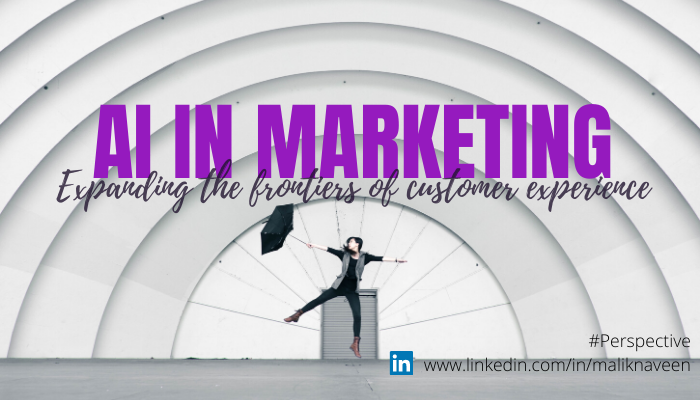
Expanding the Frontiers of Customer Experience in Marketing
The global demand for automation has never been higher. Research indicates that it could surpass an astounding USD 200 billion by the end of 2020. With a deep impact across industries such as manufacturing, financial services, aviation, transportation, energy, and telecommunications, automation will be the single biggest IT investment for most industries. While process automation is key to this transition, the single biggest driver for industries will be the resultant change in customer experience.
Artificial intelligence (AI), machine learning (ML), predictive analytics, and a host of other key technologies and solutions are expected to play a critical role in this transition. These offerings are helping transform the way automation appears on the organizational roadmap. This trend will only get stronger with the arrival of integrated automation (IA), which is expected to expand and transform the manner in which organizations interact with their customers.
Integrated Automation and Business
Traditional automation has focused on simply automating repetitive tasks while IA is a convergence of automation and AI/ML which opens up a whole new world of possibilities. Intelligent automation platforms will eventually subsume and even supplant conventional automation solutions and move well beyond rule-based automation, conditional routing, logical operations, and learning-based behavioral modifications.
Integrated automation systems are designed to focus on enabling contextual awareness and guidance for complex, unstructured interactions that can deliver business outcomes. This is why the growth of IA is being further accelerated by transformations within Business Process Management (BPM) applications and the rise of Integrated Process Automation (IPA).
IPA is a managerial/contextual approach that focusses on transforming and enriching customer experiences that deliver more than just cost savings and can deliver an engaging customer experience. For businesses, IPA can radically impact domains such as marketing by filling the gaps between data and execution. With IPA-based marketing solutions, organizations can rapidly analyze vast quantities of data for business insights that can help drive their marketing campaigns.
Integrated Automation in Marketing
Given the vast array of data points like social media, voice-assistants, location data, online content, and more, businesses with AI on their side can truly understand their customers. This data is instrumental in gaining deeper insights into customer preferences, intentions, and habits. With a greater understanding of their customer, organizations can deploy marketing strategies that are more likely to gain traction and engage customers.
Consider the examples of media providers like Amazon and Netflix who have consistently used AI-based tools to grow their customer engagement. These companies leverage numerous data points to personalize their content recommendations. Most recently, Sky, the British telecommunications company, implemented an ML-based model that aimed to take this a step further.
So while data points like demographics, viewing behavior, and watching preferences remain key, Sky’s new model also factors in a user’s mood at the time. The company developed this capability by having the system interact with the customer and simply ask them to select mood “bubbles” on their user interface. This widespread interaction essentially let to a new ontological sorting of content by users based on their mood descriptions. The result – users can now search for content based on their mood and even mix-and-match moods to find the right content for their viewing.
AI is here to stay and is an integral part of a silent revolution that is happening even as we speak. But then, not all revolutions are violent – some take place without a shot being fired.
Delivering the Desired Results
Integrated automation lays the groundwork for the next logical evolution towards accelerating business operations. As a feature-rich development platform for content- and process-oriented applications, and a method for extracting knowledge from automated executions to meet the innovation and efficiency needs of the enterprise, the framework ensures outcomes that are collaborative, dynamic, intelligent, and responsive towards customer demands.
In today’s data-driven environment, the digital backbone of the framework leverages digitization and seamless process automation to ensure data consolidation, cloudification, and security. The smart network created as a result of IA is capable of predictive analytics and is equipped with cognitive AI processes, ML, blockchain and IoT. This results in autonomous and agile work culture, supported by an inclusive digital mindset, and a focus on unified outcomes.
In the realm of digital marketing, these new benefits become all the more apparent. Today, IA-based solutions are enabling digital marketers to leverage data and insight that was previously inaccessible. For example, Samsung and consumer insights company Crimson Hexagon used social listening and sentiment analysis to proactively detect and mitigate negative customer reactions when their S8-line of mobile phones encountered some errors. This kind of cognitive AI process can find widespread utilization across businesses to enhance strategies that improve customer experience.
The introduction of cognitive assistants further helps strengthen the role of IA in defining the future of organizations willing to transform their customer experience paradigm. The ability to combine elements of process automation, AI, and smart analytics into an integrated solution is, therefore, resulting in these assistants replacing the traditional bots across functions. They are increasingly becoming indispensable for driving direct customer correspondence, augmenting the efforts of a customer service representative, and helping middle and back-office processes get completed more intelligently and efficiently.